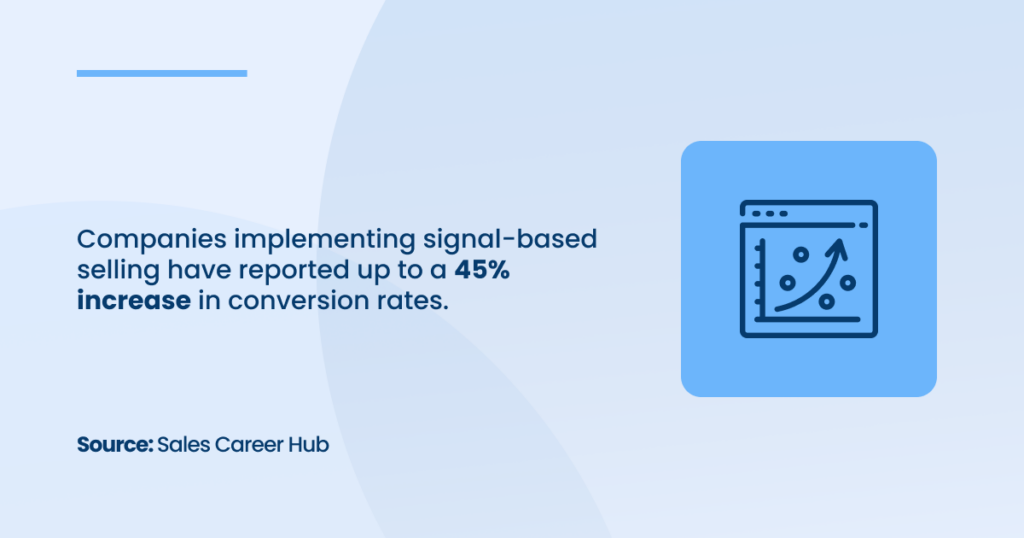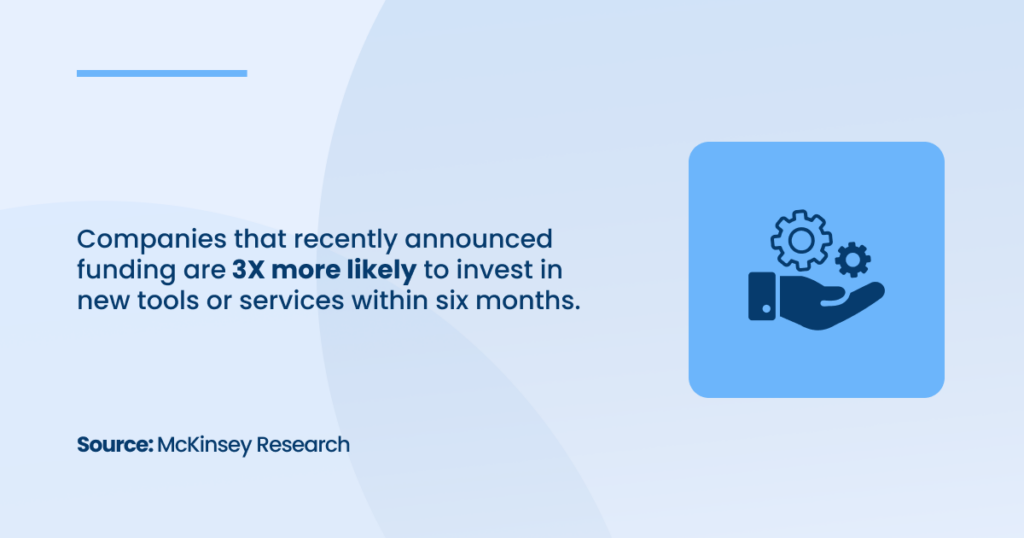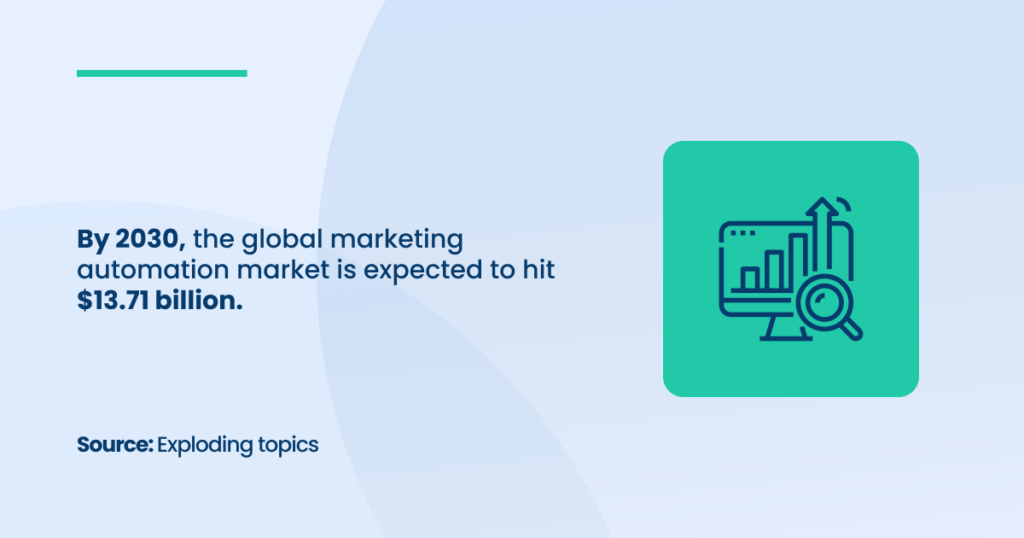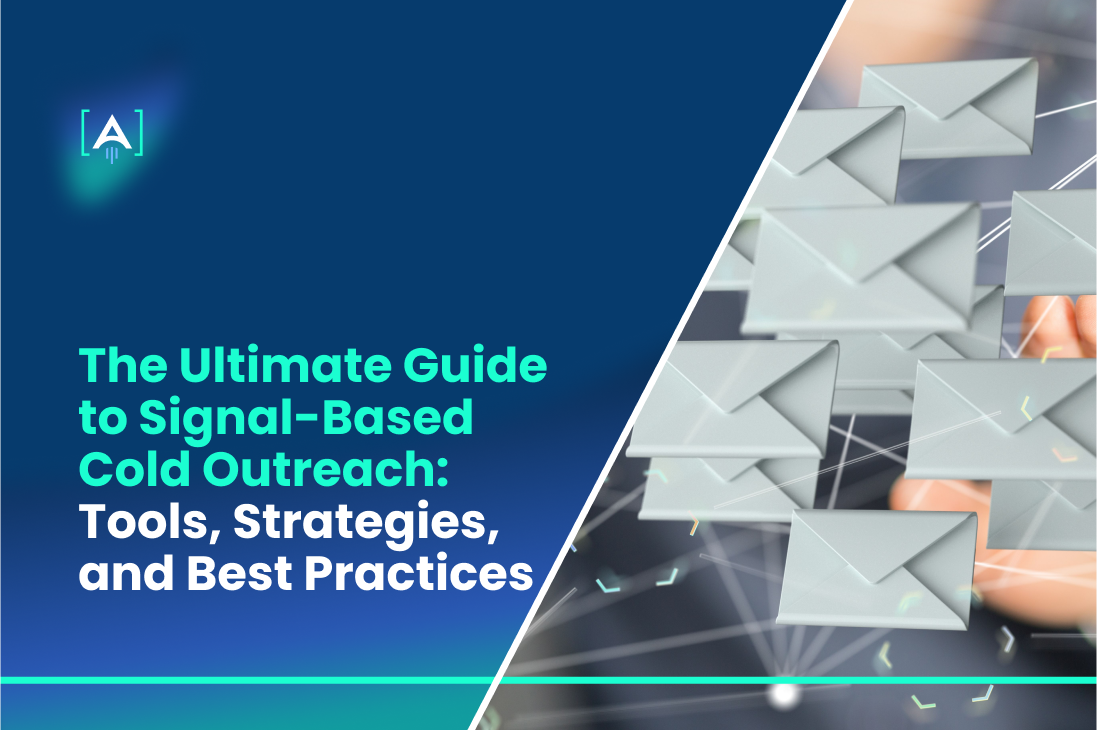Multichannel vs. Single-Channel Outreach: The Pros and Cons Explained
Imagine this:
You’re scrolling through your email inbox, and one subject line catches your eye—it mentions a problem you discussed in a meeting yesterday.
Intrigued, you open it, and it feels like the sender has been listening to your thoughts.
This is the magic of signal-based cold outreach.
Instead of blasting generic messages into the void, signal-based outreach listens first. It’s about picking up on signals—hints of interest, activity, or intent—and using them to craft a message that feels less like a cold call and more like a warm handshake.

Whether it’s a social media comment, a job change on LinkedIn, or a recent company milestone, these signals are goldmines for connecting with your prospects in a timely, relevant, and personal way.
Here is where our Signal-Based Cold Outreach Agency will enlighten you on how to harness these signals effectively.
In this article, we’ll explore how signal-based outreach isn’t just a trend but a smarter way to build meaningful connections in today’s noisy digital world.
Spotting Gold: Where to Find Outreach-Worthy Signals
Regarding cold outreach, the right signal can turn a cold lead into a warm prospect. But how do you spot these signals in the first place?
Think of signals as small, meaningful breadcrumbs left by your potential clients online.
These could be LinkedIn updates, social media comments, or even news about a company’s funding round.
By identifying these “golden nuggets,” you can craft outreach messages that resonate and drive results.
LinkedIn Updates: The Treasure Trove for Decision-Maker Insights
LinkedIn is a powerhouse for cold email outreach.
Why? Because decision-makers are already using it to share their professional milestones, connect with peers, and engage with industry news. Here’s how you can mine LinkedIn for outreach-worthy signals:
Key Signals to Watch for on LinkedIn
- Job Changes: When someone starts a new role, they often look to make an impact quickly. For example:
- A newly appointed CMO might be seeking marketing solutions to boost brand presence.
- A freshly promoted CFO could be revisiting cost-management tools.
- Skills Endorsements and Certifications: If a decision-maker is endorsed for a specific skill, it can hint at their focus area. For example:
- An endorsement for “data analytics” could indicate the prospect values data-driven tools.
- Content Engagement: Pay attention to what they’re liking, commenting on, or sharing. This can reveal:
- Their industry pain points.
- The tools or strategies they’re currently exploring.
- Hiring Activity: Companies actively hiring for key positions signal growth. For instance:
- A tech company looking for software engineers might be scaling their infrastructure.
Pro Tip: Leverage LinkedIn Sales Navigator to set up alerts for these updates. With features like advanced search and lead recommendations, it’s easier to track your ideal customer profiles (ICPs) and their activities.
Milestones and More: Turning Announcements into Opportunities
Company milestones, like funding rounds, product launches, or expansion into new markets, are signals rich with outreach potential.
These events signal growth and present new challenges your business can help solve.

Where to Find Milestone Signals
- Company News Sections: Regularly check news updates on company websites or press releases for:
- Funding announcements.
- Leadership changes.
- New office locations.
- Industry News Platforms: Use platforms like Crunchbase and TechCrunch to stay updated on:
- Startup funding.
- Partnerships and acquisitions.
- Google Alerts: Set up Google Alerts for relevant keywords like:
- “[Company Name] funding announcement.”
- “[Industry] expansion.”
Examples of Milestone-Based Outreach
- Funding Round: If a company has just closed a funding round:
- Example Outreach: “Congrats on securing $10M in Series A funding! I’d love to discuss how our [product/service] can support your next phase of growth.”
- Product Launch: A product announcement indicates a company is seeking visibility.
- Example Outreach: “Saw your recent product launch—congrats! We specialize in helping companies like yours amplify their reach.”
The Power of Personalization: Crafting Messages That Click
Personalization in cold outreach isn’t just a “nice-to-have”; it’s a must.
Imagine receiving two emails.
One says, “Hi, here’s what we offer,” and the other says, “Hi [Your Name], I noticed your company recently expanded into Europe, and I wanted to share how we helped businesses like yours navigate this transition smoothly.”
Which one grabs your attention?
Personalization is the difference between blending into the crowd and standing out.
Source: Mckinsey Report
Personalized messages show you’ve done your homework.
They tell the recipient, “You’re not just another name on a list; I see you.” This approach not only fosters trust but also significantly improves engagement.
Studies show that personalized emails generate a 26% higher open rate and a 29% increase in reply rates compared to generic templates.
In the world of signal-based outreach, personalization goes beyond just knowing someone’s name or job title. It’s about leveraging the signals—like a LinkedIn post about a recent achievement or a comment on industry challenges—and connecting them to your message.
Think of it as joining the dots between what they’re saying and what you’re offering. The result? A message that feels less like a pitch and more like a conversation.
Stop Sounding Generic: How to Personalize Like a Pro
Personalization starts with listening.
Signals, whether from LinkedIn updates, news about a company milestone, or even a tweet, are your gateway to understanding what matters to your prospect. Yet, many still make the mistake of using generic templates that fail to resonate.
Source: McKinsey Research
In cold email outreach, this is the quickest way to the trash folder.
So, how do you get it right?
Begin by identifying the “why” behind your outreach. If you’ve noticed a prospect posting about hiring challenges, your email should directly address how your solution simplifies recruitment processes.
If they’ve announced a funding round, congratulate them and tie it to how you can help them scale efficiently. This isn’t just a strategy; it’s the heart of a cold outreach guide—connecting your value to their immediate needs.
Avoid email outreach mistakes like overloading your message with jargon or focusing solely on your product. Instead, focus on them. Here’s a framework that works:
Start with a genuine acknowledgment of their signal.
For instance, “I saw your LinkedIn post about launching in Asia-Pacific—congratulations! It’s a huge milestone.”
Then, transition into how you can help, “Scaling internationally comes with unique challenges. We specialize in streamlining [specific challenge], ensuring your team can focus on growth.”
This approach does two things: it shows you’re paying attention, and it positions your outreach as a solution to their challenges, not just another sales pitch.
Why Personalization Pays Off
Personalization isn’t just about standing out—it’s about results.
Cold emails that include context-relevant personalization are 40% more likely to lead to a response. For CEOs and business owners, this translates to better ROI on your outreach workflows and a stronger pipeline of qualified leads.
However, the benefits extend beyond response rates.
Personalized messages build credibility and trust, which are essential in long-term business relationships.
Whether you’re leveraging email and LinkedIn outreach or experimenting with new outreach workflows, the principles of personalization remain the same: listen, connect, and deliver value.
Smart Tools for Signal Detection and Outreach Automation
In today’s business landscape, success in cold outreach is not just about working hard; it’s about working smart.
For CEOs and business owners, spotting the right signals—the small but crucial cues that indicate a prospect’s interest or need—is like finding gold. The challenge? Doing it consistently and at scale. That’s where technology becomes your best ally.
Signal-based outreach thrives on tools that help you monitor, identify, and act on key triggers, such as job changes, company announcements, or industry updates.
Without these tools, your outreach becomes a guessing game, and guesswork rarely wins in business.
LinkedIn Sales Navigator: The Treasure Hunter’s Dream
LinkedIn Sales Navigator is more than just a search tool—it’s a goldmine for signal-based outreach.
With its advanced filters and lead insights, this tool ensures you’re targeting the right people at the right time.
Multichannel vs. Single-Channel Outreach: The Pros and Cons Explained
Key Features CEOs Love:
- Advanced Search Filters: Narrow down prospects based on job title, industry, and location. For example, you can easily find decision-makers who recently joined a company or are in leadership roles.
- “Spotlight” Signals: Get real-time updates on promotions, new connections, or recent posts—perfect cues to craft a timely and personalized email subject line.
- CRM Integration: Sync your LinkedIn leads with your CRM for seamless outreach workflows.
Using LinkedIn Sales Navigator can improve your cold email open rates by allowing you to craft messages that are timely and relevant. Imagine reaching out to a CEO who just posted about a new funding round. Your message is now part of a conversation they care about.
Google Alerts: Your 24/7 Signal Scout
Think of Google Alerts as your personal assistant, keeping an ear to the ground for any news or updates about your prospects.
It’s simple, free, and incredibly effective for CEOs who want to stay informed without spending hours browsing.
Why It’s a Must-Have:
- Keyword Monitoring: Track mentions of companies, industry terms, or even specific competitors. Set up alerts for phrases like “hiring spree,” “new partnership,” or “merger announcement.”
- Customizable Alerts: Get notifications straight to your inbox, ensuring you never miss an outreach-worthy signal.
- Effortless Scalability: Monitor multiple keywords across different industries without extra effort.
You can tailor your personalized outreach to address timely topics by acting on Google Alerts signals.
For instance, congratulating a company on a recent acquisition and positioning your service as a solution to their scaling challenges.
Email Automation Platforms: The Backbone of Smarter Outreach
Tools like HubSpot, Snov.io, or Instantly are the secret weapons behind effective cold email outreach.

They take the repetitive tasks off your plate, allowing you to focus on strategy and personalization.
How They Empower CEOs:
- Personalization at Scale: Automation tools enable dynamic fields, so your emails can include specific details like names, job titles, and even pain points. This prevents the dreaded email outreach mistakes like “Hi [Insert Name].”
- Drip Campaigns: Send a series of follow-ups automatically, ensuring no lead slips through the cracks. A well-designed drip campaign can increase reply rates by up to 80%.
- Analytics and A/B Testing: Know which subject lines and CTAs perform best, helping you refine your cold outreach guide with data-driven insights.
A CEO using email automation can free up hours of manual work while maintaining a personal touch. It’s the perfect blend of efficiency and effectiveness.
Timing Is Everything: Reaching Out When It Matters Most
Timing in cold outreach can be the difference between success and being ignored.
Imagine spotting a LinkedIn update announcing a prospect’s recent promotion or learning about a company’s new funding round—what you do next and how fast you do it, matters immensely.
Signals like these are fleeting; if you delay, you risk losing your window of opportunity.
Why Speed Matters in Signal-Based Outreach
The first responder often wins.
Businesses that follow up within five minutes of a signal have a 900% higher chance of converting a lead than those that wait 30 minutes.
Why? Signs often indicate a prospect is already thinking about their needs, making them more receptive to your message. Waiting too long, even by hours, allows competitors to swoop in or the prospect to lose focus.
For example:
- A prospect who updates their LinkedIn profile to reflect a new job title may already be evaluating vendors for their new responsibilities. A quick, well-crafted, cold email outreach message tailored to their role will catch their attention before others do.
- A company announcing new funding might be overwhelmed with pitches. The first few, especially if relevant and timely, stand out.
In short, timing isn’t just about efficiency—it’s about staying relevant.
Measuring Success: How to Know Your Timing Works
Timing your cold email outreach is as much an art as a science.
To refine your strategy:
- Track Response Times: Use analytics tools to measure how quickly you’re responding to signals. Aim to reduce this time continually.
- Monitor Open Rates: Higher cold email open rates often indicate that your timing aligns with your prospect’s schedule.
- Analyze Conversion Metrics: Measure how often a timely response leads to a meeting or a sale.
Overcoming the Spam Filter: How to Stay Relevant and Compliant
For CEOs and business owners, few things are as frustrating as a perfectly crafted cold email ending up in a prospect’s spam folder.
Imagine dedicating time to research, creating personalized email subject lines, and developing an engaging message—only for it to never be seen.
Spam filters, while essential for inbox hygiene, can be unforgiving even to legitimate and thoughtful outreach.
What Triggers Spam Filters?
Spam filters are programmed to detect and block emails that appear suspicious or irrelevant.
Unfortunately, even legitimate multichannel outreach efforts can get caught in these digital nets.
Here are common reasons why emails get flagged:
- Spammy Words or Phrases: Terms like “free,” “urgent,” or “limited-time offer” can raise red flags.
- Excessive Links or Attachments: Emails with multiple links or large attachments often look like phishing attempts.
- Missing Personalization: Generic, mass-sent emails signal a lack of relevance, reducing engagement and raising spam flags.
- Weak Authentication: Poor technical setup, like missing SPF, DKIM, or DMARC records, can harm your domain’s reputation.
These factors don’t just impact one email—they can damage your sender’s reputation, leading to more of your emails being blocked in the future.
How CEOs Can Build a Spam-Free Foundation
Understanding the technical and strategic essentials ensures your outreach workflows succeed.
Here’s how you can optimize your efforts:
- Authenticate Your Domain: Work with your IT team to set up SPF, DKIM, and DMARC protocols. These authentication methods tell email providers your messages are trustworthy.
- Warm Up Your Email Account: Gradually increase the emails sent from a new account. Start with small, personal campaigns before scaling.
- Keep Your List Clean: Regularly update your email list to remove invalid or inactive addresses. This minimizes bounce rates and improves your sender score.
- Be Transparent: Display your company’s name, address, and an easy opt-out option in every email. This isn’t just good practice—it’s legally required.
Creative Strategies to Stand Out Without Breaking Rules
Compliance doesn’t mean being boring.
In fact, creativity is your best ally in crafting emails that bypass spam filters and resonate with your audience.
1. Personalize Like a Pro
Instead of starting your email with “Dear Sir/Madam,” dive into specifics. Mention the recipient’s name, recent LinkedIn activity, or a milestone their company achieved. Use personalized email subject lines like:
- “Excited about [Company]’s growth—an idea for you.”
- “Saw [Milestone]—let’s make it even bigger.”
2. Use Plain Text Wisely
While flashy designs may seem appealing, plain-text emails often have better deliverability rates. Keep the layout clean and focus on the message. Plain text also feels more personal, as though it’s written just for the recipient.
3. Don’t Overdo Links
Limit the number of hyperlinks in your email. Instead of flooding the email with links, focus on one strong call-to-action (CTA) that aligns with the recipient’s needs. For example:
- “Here’s a quick case study you’ll find relevant.”
- “Can we connect for 10 minutes this week?”
4. Test Your Subject Lines
Subject lines can make or break your email. A good subject line not only grabs attention but also avoids spam-triggering words. A/B test subject lines to discover what resonates most with your audience.
Wrapping It Up: Outreach That Resonates, Not Rebounds
Signal-based cold outreach is your chance to stand out. You can build trust by spotting the right signals, crafting personalized messages, and staying compliant while achieving real results.
[A] Growth Agency will guide you every step of the way—helping you identify high-value signals, leverage cutting-edge tools, and execute multichannel outreach strategies.
Growth is our driving force. We believe in the power of data to inform and drive every strategy, ensuring our actions are as effective as they are innovative.
Remember, every interaction is an opportunity to show your prospects that you’re paying attention.
Don’t Settle for Less.

